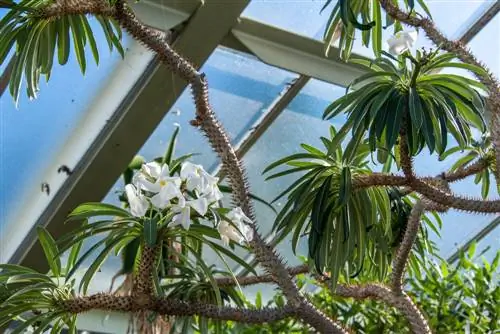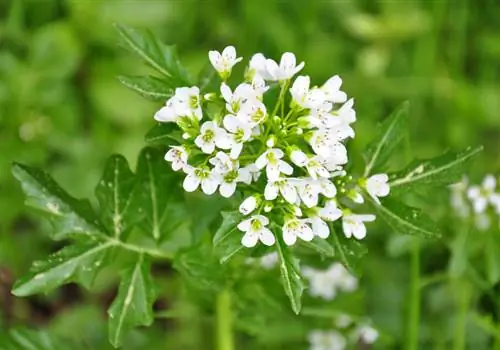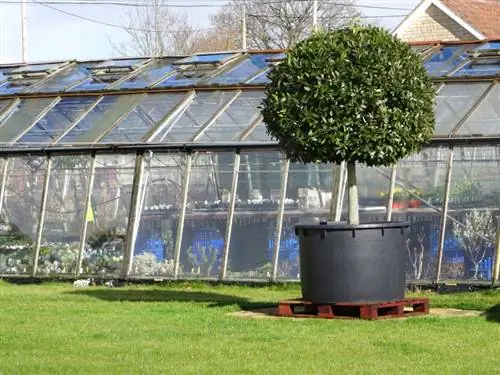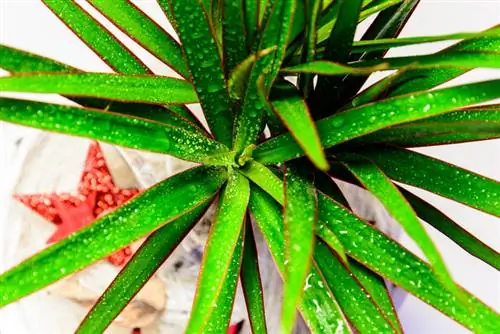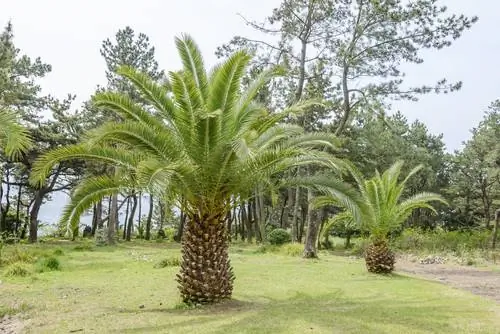- Author admin [email protected].
- Public 2023-12-25 17:45.
- Last modified 2025-01-23 11:21.
The Madagascar palm gives the appearance of a palm tree. But their position in the plant kingdom is far removed from that of palm trees. The exotic beauties are popular ornamental plants that grow quickly and develop interesting growth forms. Regarding care and location, there are a few aspects you need to consider to make cultivation a success.
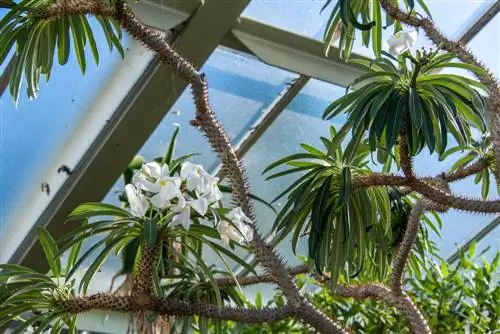
How do I care for and propagate a Madagascar palm?
The Madagascar palm (Pachypodium lamerei) is an exotic ornamental plant from Madagascar and belongs to the dogpoison family. It needs a warm, bright location without direct sunlight, permeable substrate, regular watering and nutrient supply during the growth phase. Propagation occurs through cuttings or seeds.
Origin
The Madagascar palm has the Latin name Pachypodium lamerei and belongs to the dogpoison family. Apart from its German name, the plant has no characteristics in common with palm trees. Their distribution area is Madagascar. It is the only natural area of its kind in the world. It is concentrated in southern and central Madagascar.
The Madagascar palm, also known as the fatfoot or star of the steppe, is a popular ornamental plant in living rooms and greenhouses.
Growth
This plant is a succulent. It develops a cone-shaped trunk that is hardly branched and does not become woody. It is created by leaf tissue nested one on top of the other. Its surface is covered with numerous thorns. This trunk can grow to a height of around 200 centimeters when cultivated. In their natural distribution area, the plants reach heights of up to six meters. Their annual growth is between 15 and 30 centimeters. The older the plants get, the faster they grow.
The special growth habit of the Madagascar palm is an adaptation to the climatic conditions. It can store water in its trunk so that it can easily survive longer dry periods. The succulent plant develops leaves that form a kind of crown. In the dry season the fatfoot sheds its leaves. This is also an adaptation because it prevents the plant from losing excessive fluids.
leaves
Pachypodium lamerei develops leaves that are arranged alternately and cluster together like a crest. They are divided into a three to four centimeter long stem and a leathery leaf blade up to 25 centimeters in size. Its surface is colored dark green and has light midribs.
The linear-shaped leaves arise from the warts. These structures are comparable to nodes on branches or sleeping eyes on rhizomes. The stipules, which are formed at the base of the stem, are transformed into thorns in Madagascar palms. There are three thorns in one leaf axil.
Bloom
Madagascar palms develop aesthetic individual flowers whose five white-colored petals are arranged like a star. Its base has grown into a funnel, which opens with whorled petal edges on top of each other. The flower center appears bright yellow. The organs of the hermaphrodite flowers are hidden deep in the corolla tube so that only certain pollinators can reach them.
The sepals are very short developed compared to the corolla tube. They are fused together and form a five-pointed calyx tube. It takes several years for the Madagascar palm to bloom for the first time. When grown indoors, the plants only bloom very rarely.
offshoot
In rare cases, Madagascar palms develop side shoots that can be used for propagation. These are cut off during the growth phase and air-dried until no more milky juice comes out of the cut. You can place the offshoot with the unleafed part in a glass of water or in moist potting soil.
This is what you need to pay attention to:
- Use cactus soil as a growing substrate
- Place the cultivation container in a bright and warm location
- Avoid direct sunlight
- if new leaves form, the offshoot should be repotted
read more
Usage
Madagascar palms are not only suitable for greenhouses in botanical gardens. They decorate living rooms and winter gardens as houseplants. The pulp is used as an ingredient in the production of cosmetics.
Is Madagascar palm poisonous?
It is believed that Madagascar palms are poisonous, similar to other poisonous plants. To date, there are no precise descriptions of the structure of the ingredients. Pachypodium lamerei is said to contain cardenolides, which are cardiac toxins. Symptoms of poisoning can occur in both humans and pets.
Protect your hands when you need to cut the plant. A white milky sap emerges from the wounds, which can cause severe burns to the skin.read more
Which location is suitable?
The thickfoot prefers a warm location with sufficient light, although the succulent does not like direct sunlight. A bright location in partial shade offers the plant ideal growing conditions. When choosing a location, you should pay attention to a balanced relationship between temperature and light. The warmer it is, the more light the plant needs. A suboptimal location promotes the spread of diseases and pests.
Place your Madagascar palm in a west or east facing window. In summer you can put the plant outside. A sheltered spot on the south side of the house is ideal. You can also place the succulent in covered corners on the terrace or balcony, as this is where the heat accumulates.
If your plant is outdoors, pay attention to:
- Protection from cold winds and rain
- Temperatures of at least 15 degrees Celsius at night
- minimum nighttime temperatures of 18 degrees Celsius when the plant is young
What soil does the plant need?
The substrate should be nutrient-rich and have a loose structure. Use potting soil or potting soil that you loosen up with sand, coconut fibers or cactus soil. Such mixtures increase the permeability of the substrate and prevent the soil from retaining too much moisture. Alternatively, you can use special mixes for cacti and succulents. Since these substrates are poor in nutrients, you will have to fertilize or repot more often.
Sowing
When an older Madagascar palm develops flowers for the first time, you can collect seeds after successful pollination. You support seed formation by pollinating the flowers with a brush. After collecting the seeds, they are stored until next spring. Ensure dry and dark storage conditions.
Sow the seeds thinly on a nutrient-poor growing substrate and only cover the seeds lightly with soil. Moisten the substrate and cover the planter with transparent film. Place the pot in a warm location with plenty of light. You can place the growing container on a windowsill with direct sunlight.
The germination success rate is highest at temperatures between 24 and 30 degrees Celsius. If you cannot guarantee these conditions, we recommend growing in a heated windowsill greenhouse.
Madagascar palm in a pot
The fatfoot is cultivated as a container plant. Make sure that the water can drain easily. Waterlogging in the substrate affects plant he alth because the roots rot and fungal spores find optimal growth conditions. You can prevent waterlogging by choosing a pot with a drainage hole.
Place pebbles, pottery shards or expanded clay over the drain hole. In this way, no substrate trickles out of the hole and the irrigation water can drain away better. Clay pots are more suitable for cultivation than plastic containers. The natural material can better regulate the moisture in the substrate because the water penetrates the pores and evaporates on the outside.
Watering Madagascar palm
In the natural area of the Madagascar palm, rainy seasons alternate with dry periods. While the plants grow in phases with high rainfall, they go into a dormant state when there is a lack of water. These conditions should be imitated in cultivation. You can adjust the rainy and dry seasons according to the seasons.
Start watering regularly in spring. Allow the substrate to dry superficially before each watering session. Water thoroughly so that the stem tissue can soak up water. The water requirement of the Madagascar palm is significantly higher than that of other succulents. The more you water, the more leaf mass will grow. In the fall, reduce watering until the plant has shed all of its leaves. Then moisten the substrate with a little water so that it does not dry out completely and become cracked.
Use stale tap water and filter it if necessary. The plant cannot tolerate hard water. Rainwater is well suited.
Shorten
Pruning is unnecessary with this exotic plant. A section of the crown will cause the plant to die. Wilted or diseased leaves can be removed at any time with a sharp knife. If your plant grows too much, you can reduce the watering slightly. Changing the location to a darker location also slows down the growth rate.read more
Fertilize Madagascar palm properly
Fertilizing, like irrigation, is adapted to the natural growth phases. A supply of nutrients is recommended during the growth phase. If this extends over the summer, you can start fertilizing in April. Give the plant additional nutrients in the form of a complete liquid fertilizer at regular intervals until September. This is administered in a weak concentration via the irrigation water. More than one fertilizer application per month is not necessary.
If your plant grows and rests regardless of the seasons, focus on the fresh shoots. If these have been visible for four weeks, start with the first fertilization. Give the plant additional nutrients once a month. The measure will be discontinued approximately four to six months after the first treatment.
Repotting
About every two to three years the roots have grown through the substrate in the pot and the plant needs a larger planter. Remove the old substrate completely and rinse off any residue under water. In order to handle the Madagascar palm during this measure, it has proven useful to wrap the trunk several times with thick foil. Gloves are not enough as the strong thorns penetrate the material.
How to transplant the succulent:
- in spring or before the growth phase
- mix fresh and nutrient-rich substrate with sand
- line a new bucket with pottery shards
- Insert the plant, fill with substrate and water
- refrain from additional fertilization
read more
Wintering
If you cultivate your fatfoot outside in the summer, bring the bucket indoors in the fall. The temperature in the winter quarters at this time should be 18 degrees Celsius. A sharp drop in temperature between the outdoor location and the winter quarters weakens the plant. Then move the pot when the temperatures of both locations are similar.
If the Madagascar palm is in the house all year round, you can put the plant in a mild and bright place in winter. Overwintering near a heater does not cause any problems for the plant. She likes a warm winter quarter where the thermometer does not drop below 18 degrees Celsius. Adjust watering to the plant's needs. The darker it is, the less you have to water.
If you don't cut back on care, the plant will keep its leaves. It does not go dormant and uses the water for leaf development. However, periods of rest are important for the he alth of the plant. Weakened plants become susceptible to diseases.read more
Fungal infestation
If water drainage is not guaranteed, waterlogging can accumulate in the substrate. This leads to rotting of the roots. You should water with caution, especially in winter, as the plants need less water and the substrate quickly becomes too moist. A cold floor also promotes rotting processes.
Fungal spores can settle on the affected roots and harm the plant. It loses leaves and dies if infested severely. As soon as the first signs of waterlogging appear, you should place the plant in fresh soil. Completely remove the old substrate and cut off any rotten roots. You should not water the plant in the near future so that the roots can recover.
Pests
There can occasionally be an infestation of scale insects, which spread preferentially during the cold season. Dry air, warm temperatures and a location that is too dark promote the spread of pests. They leave a sticky film on the underside of the leaves and on the trunk. Scale insects feed on plant sap and secrete this honeydew. Dabbing the pests with a cotton swab soaked in tea tree oil has proven to be an effective control method. Special species of parasitic wasps serve as beneficial insects. Sustainable control usually requires the use of oil-based insecticides.
Brown leaves
It is common for Madagascar palms to develop brown to black leaf tips. The discoloration can spread to the entire leaf and indicates suboptimal environmental conditions. Various factors may come into question, which should be checked one after the other. Lack of nutrients, waterlogging and too high a pH value as well as drafts and a location that is too dark can damage the plant. If the roots hit the pot, this damage can also occur.
Tip
The already top-heavy plants shift their center of gravity ever higher as they grow. You can give the pot additional stability by placing it in a larger pot. Fill the gap with pebbles. For smaller specimens, you can cover the substrate with larger stones.
Varieties
- Pachypodium saundersii: Silver-gray trunk with warty thickenings, diverse in shape. Leaves with slightly wavy edge. Grows up to six meters high.
- Pachypodium geayi: Narrow leaves, silver-green. Trunk cylindrical. Growth height four to five meters.
- Pachypodium rutenbergianum: Sparsely branched, bottle-shaped trunk. Flowers delicate pink. Grows three to eight meters high.

